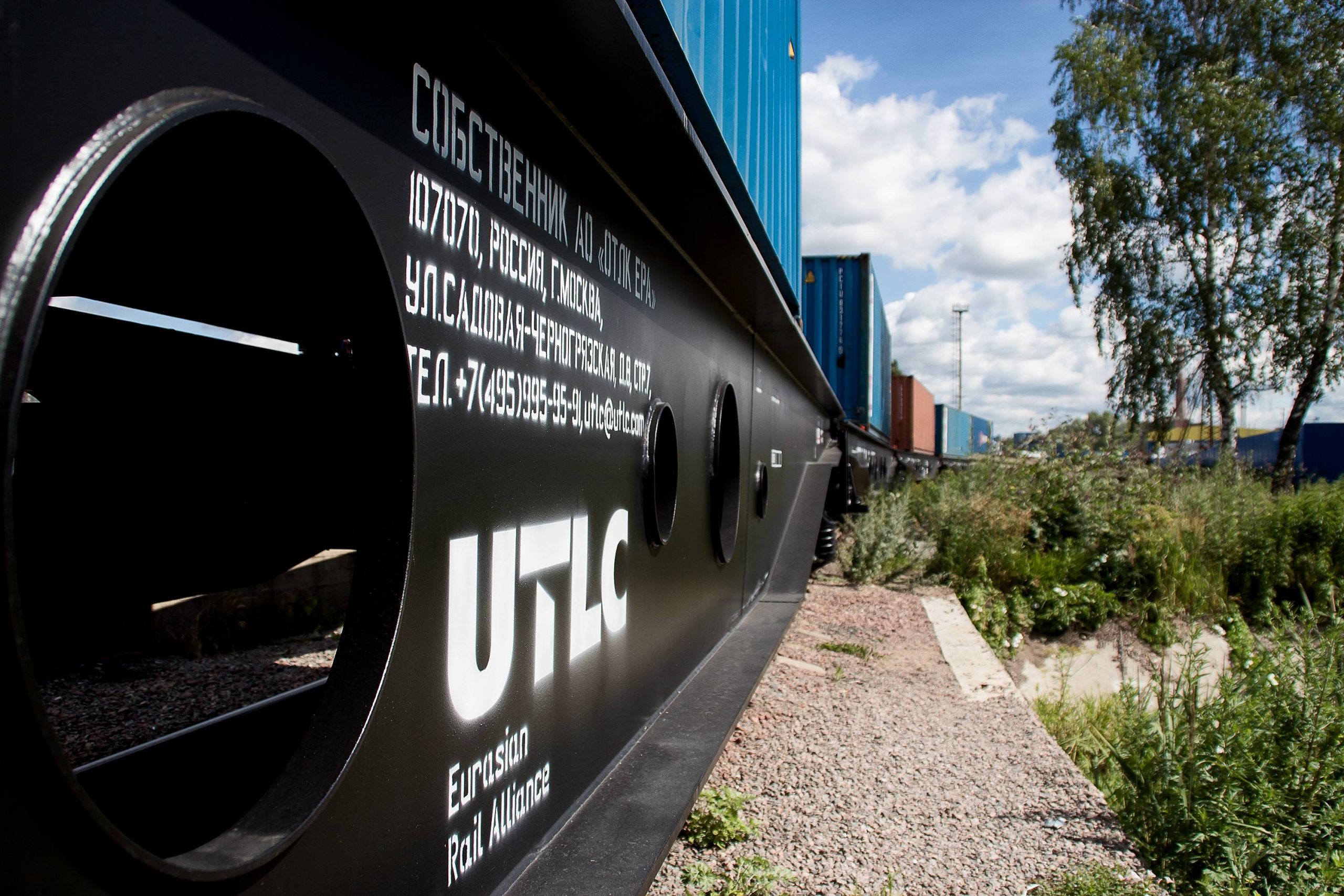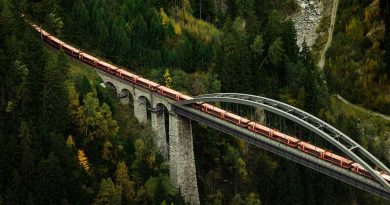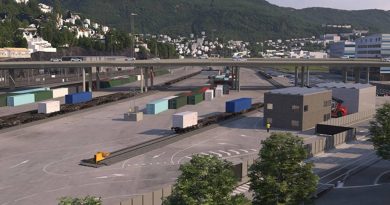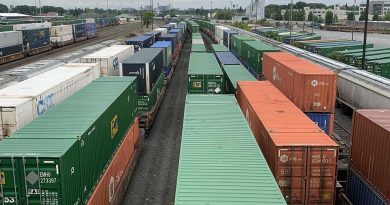Alexey Grom, CEO of UTLC ERA – I predict great opportunities for the railroad industry
Today, it’s quite difficult to make predictions as the uncertainty has become one of the key tendencies but for some reason, I believe that 2021, for instance, will be a year when companies effectively walk away from the pandemic crisis ramifications, and, in my opinion, it will be the time for unlimited opportunities for the railway transport and associated freight forwarders – Alexey Grom, CEO of joint-stock company UTLC ERA, said in an exclusive interview for the PlutonLogistics portal.
UTLC ERA is a joint venture of Russian, Belarusian, and Kazakhstan railways. It provides container transport services by regular block trains on the China-Europe-China route through the territory of Russia, Belarus, and Kazakhstan. Although the immediate reason for the interview was the fact that, out of all types of freight transport to and from China, the railway proved to be the most resistant to the pandemic, what proved to be more even important were the great expectation for this sector, which our interlocutor pointed out:
If we keep working in a coordinated manner and grow together, we can ‘win’ really good volumes. So, today I can predict great opportunities for the railroad industry!
PL: Eurasian railway container traffic has been experiencing strong growth this year. In May, UTLC ERA also set an important record – the results realized in the same month in 2019 have been doubled. Could you give us more details about the results achieved over the past months? What are the overall expectations for 2020?
– In 2020, the global product supply chains between Europe and Asia were under the threat of disruption due to the COVID-19 pandemic. This was the time when the railway virtually became the only channel for regular supplies between China and the EU.
This time was marked with the phenomenon known as the ‘modal shift’; the traditional role of the railway transport serving as a supplement to the marine transport has changed in the global supply chains, and now we can witness a dynamic shift of the volume of traffic to transit railway services.
The volume of carriage by UTLC ERA regular services has been growing for six months in a row. The growth doubled for the first time the last April; the traffic volume reached 41,200 TEU. In August, we transported over 56,000 TEU.
Totally, the volumes of container traffic along the China-Europe-China route by the UTLC ERA transit services have increased beyond 400,000 TEU since the beginning of the year. By year-end, we expect to have transported half a million TEU.
PL: What are the main factors that have made such growth possible? How much did the situation in the air transport sector, i.e. the lack of flights caused by the coronavirus pandemic, contribute to these results?
I’d rather put away the reasons and focus on the fact that the railway appeared to be more resilient to the crisis for which we can be credited as well. The railway transit for cargo shippers is a pillar of stability and predictability of business processes based on the timely cargo dispatch which becomes even more important amidst the overall uncertainty in the world.
The best price-to-service speed ratio is the unmatched advantage of the railway mode of transportation during transcontinental communication which allows the large business to respond to market changes quicker and more flexible and, therefore, to have more resources to keep the situation under control.
Currently, container trains managed by the UTLC ERA services are traveling 1,100 km every 24 hours covering the distance from the Chinese border to the EU border in five or six days, depending on the route.
The ban on passenger air travel due to the pandemic was a major setback for the cargo capacity of the entire industry. In March, the capacity was reduced by 45%.
A dramatic reduction in the number of flights offered by passenger airline services due to the pandemic resulted in a decrease in the supply in the air cargo traffic market and the total capacity scarcity. At the same time, the demand for expedited delivery of personal protection equipment soared. These factors caused the quadrupled rise in the prices for airfreight, e.g., from China to Europe.
According to our estimates, the shift from air transportation to the railway resulted in an increase of about 25-30% in the overall volume of the container transit between China and Europe under the epidemiological restrictions.
The quarantine restrictions imposed in most of the largest ports serving the deep-sea routes also led to the longer cargo delivery time. Of all the freight traffic modes serving China, the railway service proved to be the most resilient to the pandemic. During that time, the goods traffic by rail never stopped. Moreover, we managed to maintain not only the service quality and the prices at the previous pre-crisis level which is equally important but also strengthen the route capacity for future growth.
Until recently, the sea has been the longest but the cheapest way to ship containers. The international research consultancy Drewry compared the carriage cost indices by rail based on Eurasian Rail Alliance Index (ERAI) and by sea based on the World Container Index (WCI). As of September 17, the ERAI railway carriage cost index was 2,684 USD/40” and the WCI index was 2,603 USD/40”.

PL: The railway played a major role in the transport of medical equipment and material necessary in the fight against the coronavirus. What are the most significant projects you have been involved in?
– This is an important aspect associated with both track gauge 1520 and track gauge 1435. The overall infrastructure of the China-EU route performed greatly, and the railway transport made it possible to deliver anti-epidemic cargoes on a regular basis.
China calls our route the ‘Green Corridor’ or ‘Corridor of Life’ highlighting the cruciality of railway transport for delivery of anti-epidemic goods as well as other essential products in these tough times. The anti-epidemic equipment was being delivered from Chinese cities to France, Germany, Spain, Serbia, and Italy.
Here, at UTLC ERA, we of course gave priority to such cargoes and even reduced the terminal handling time. We also did our best to deliver the cargoes to customers as quickly as possible.
PL: What are your predictions when it comes to the railway freight flow in the Eurasian area in the next, say, three to five years?
– I am sure that railway transport is a key facility for strategic development in most developed countries. The industry for sure is a backbone system; it determines the people’s quality of life to a great extent.
Today, it’s quite difficult to make predictions as the uncertainty has become one of the key tendencies but for some reason, I believe that 2021, for instance, will be a year when companies effectively walk away from the pandemic crisis ramifications, and, in my opinion, it will be the time for unlimited opportunities for the railway transport and associated freight forwarders. If we keep working in a coordinated manner and grow together, we can ‘win’ really good volumes. So, today I can predict great opportunities for the railroad industry!
I also anticipate the dynamic development of container traffic and greater containerization of cargoes in general. I think that most of the cargoes will be carried in containers in five years, and they will be, of course, modernized. New types of containers will be built which may allow to diversify the nomenclature of cargoes to be delivered.
PL: You recently spoke about the new possibility of European food companies transporting their goods by rail to China. What are the conditions under which they could accomplish that today? How reliable is railway transport and do you expect growth in the upcoming period? How do such transports operate when passing through the territory of Russia, bearing in mind the sanctions on the European goods regime?
– The first shipment was made last March. It was frozen salmon shipped from the Netherlands to Duisburg from where it was dispatched to China in an accelerated container train.
Surely, it is a new page in the development of the Eurasian railway transit. Railway transport once again displayed its customer-oriented and comprehensive approach to the development of genuine Eurasian collaboration and partnership.
The inbound ‘sanctioned’ cargoes are monitored by the shipment tracking system. The system automatically collects, handles, stores, and transfers the data on the cargo location and safety to regulatory bodies. It’s a large-scale project developed jointly with the Federal Customs Service, Federal Service for Supervision in the Sphere of Transport (Rostransnadzor), Ministry of Finance, Ministry of Economic Development, Ministry of Agriculture, and OJSC Russian Railways.
The transit of sanctioned goods through the territory of Russia is allowed by Decree of the President of Russia No. 290 of June 24, 2019, providing that electronic navigation seals are used.
The E-seal ensures better safety of the cargo; it gives a signal of tampering which allows to rapidly prevent stealing or damage to the integrity of the dispatch.
This is a comfortable location for European partners where a lot of high-quality food products are produced that are important for China. Additionally, it is favorable for the Eurasian railway infrastructure as it’s a prospective location in terms of carriage volume growth.
Since the first dispatch, we have been convinced that the service of transit carriage of commodity groups from the sanction list via Russia in accelerated container trains is very popular with European and Chinese companies.
In October, the first full-length container train loaded with powdered milk and cream was dispatched. It took a long way; we organized pilot dispatches of fish, meat, and other articles. In total, at the pilot phase of the project, UTLC ERA carried out single dispatches of 101 containers loaded with the sanctioned goods. Implementation of any project is phased; the phases of planning and pilot dispatches are complete. The make-up of a full-length container train loaded with products from the sanction list is the start of the commercialization phase that provides an opportunity for European producers to ship their products to Chinese customers by rail promptly and on a regular basis.
Undoubtedly, it’s a good growth point for us and our customers in Europe. The processing time for putting a navigation seal scarcely affects the service speed. We expect a further increase in requests for carriage of the said product groups.
PL: Why is the partnership of companies from different countries important when we talk about the future and development of railway transport on the Eurasian route?
– During the toughest years for the global economy or current epidemiological situation, it was the railway system that proved to be the most stable and the eventual winner. It is the right time to boost the partnership with Chinese and European associates and make a considerable joint take-off so that the Eurasian railroad infrastructure could become even stronger, even more competitive, and be in even greater demand with the global trade.
Today, it is of utmost importance to live up to the expectations of the customers and partners who entrusted us, some for the first time, with their cargoes, and kick start new projects which may ensure further growth.

PL: UTLC ERA participated in organizing a direct train on the Belgrade-China route, which transported copper from Serbia to China. Previously, masks and other protective equipment aimed at combating the COVID-19 pandemic arrived in our capital. This service has also been labeled as the beginning of more intensive consideration to introducing regular direct railway line Serbia-China, which has been talked about a lot during the previous months. What is your opinion on these opportunities?
– The first container train made of forty-one 40-foot containers loaded with electrolytic copper departed on June 22 from Belgrade with the destination for the station of Utszyashan, Wuhan, the Hubei province. The train passed in transit the territory of Belorussia, Russia, and Kazakhstan using a regular UTLC ERA service. The containers were transshipped from the narrow track gauge to the broad gauge at border checkpoints Brest/Malaszewicze and Dostyk/Altynkol.
It was the first time that Serbian cargo shippers chose the railway, and we hope that the route will become regular. Demand, as you know, breeds supply.
I am sure that the Serbian cargo shippers and Chinese cargo receivers appreciated the option of the railway route. In return, we assure that the 1520 track gauge infrastructure has a sufficient safety margin to serve prospective regular communication between Serbia and China.
PL: The first container train traveling directly from China to the Serbian capital last October spent a month in transit. That time has now been reduced, the transit on the Wuhan-Belgrade route lasted only 15 days. How this was achieved and do you believe that the transit time can be even shorter?
– The traveling time for cargo container trains from China to Europe directly depends on the speed of movement at the sections of Chinese, Eurasian and European infrastructure as well as on the efficiency of the cooperation of the transportation process participants at track gauges 1435 and 1520.
The speed is not only the key advantage of the railway but also a huge growth potential. The joint efforts of the stakeholders ensured the high service speed and a minimum of delays in the process along the whole route of UTLC ERA on the 1520 mm track gauge. The train speed on the 1520 track gauge increases as well as the handling rate for container trains at border terminals. Great efforts are put in order to increase the data exchange rate and go digital. We know that Russia, Kazakhstan, and Belorussia have shaped the specific strategy to shorten the transit time which may allow us to deliver cargoes from the Chinese border to the EU border from five days to less than four days.
What is most important is that communication among all the transportation process participants has significantly improved. The managerial and process decision-making time is of great importance to efficiently manage the cargo flow increase.
PL: What are your general expectations when it comes to faster rail transit in the future? What is the contribution of digitalization in this field?
– In terms of hardware, the railway transport is very conservative; the locomotive carries the carriages which travel along the track. It will be the case for many years. Though, everything associated with the formation of a competitive transportation service and marketing needs to be flexibly changed and comply with the tendencies which are digitalization, innovations, and marketing.
This is mainly about the digital transformation of the railway transport by creating the unified blockchain system of shipments, the integrated digital space using the cross-cutting information technologies, and shift to the digital document flow. At the same time, measures to simplify customs procedures, digital communication with regulators, improvement of the statutory framework including the increased use of the standard CIM/SMGS consignment note and the digital form thereof need to be implemented.
We participate in several task forces of the railway companies and inter-state associations which are engaged in the discussion on digitalization of the railway consignment notes and customs declaration. Here, in UTLC ERA, we come up with initiatives based on the experience with the carried-out deliveries and the knowledge we acquired during communication with our Chinese and European partners. UTLC ERA usually participates in all the basic pilot project associated with the digitalization of the railway concerning China-Europe-China communication.
We still have a lot of tasks, and we have everything we need to keep improving the performance. The modern world is very dynamic and it requires the constant move forward and, of course, the transformation of approaches to the work. We have to become more resilient and open to changes, create innovative services, and offer new solutions to the market.






